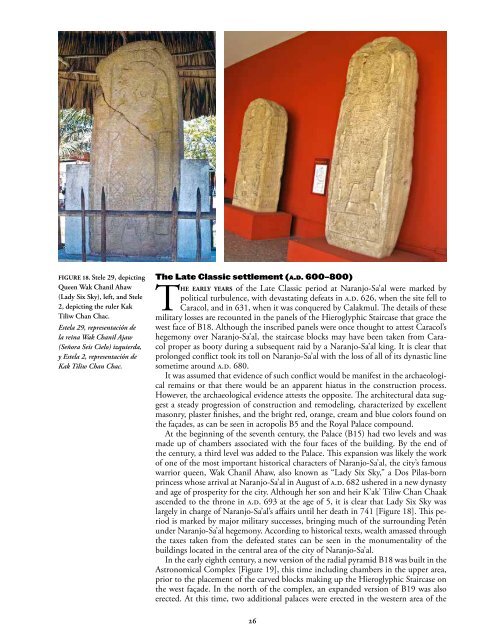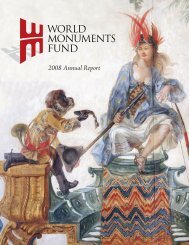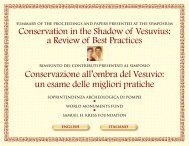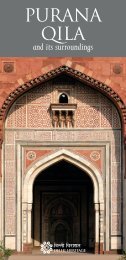NaraNjo-Sa'al - World Monuments Fund
NaraNjo-Sa'al - World Monuments Fund
NaraNjo-Sa'al - World Monuments Fund
Create successful ePaper yourself
Turn your PDF publications into a flip-book with our unique Google optimized e-Paper software.
Figure 18. Stele 29, depicting<br />
Queen Wak Chanil Ahaw<br />
(Lady Six Sky), left, and Stele<br />
2, depicting the ruler Kak<br />
Tiliw Chan Chac.<br />
Estela 29, representación de<br />
la reina Wak Chanil Ajaw<br />
(Señora Seis Cielo) izquierda,<br />
y Estela 2, representación de<br />
Kak Tiliw Chan Chac.<br />
The late Classic settlement (a.d. 600–800)<br />
The early years of the Late Classic period at Naranjo-Sa’al were marked by<br />
political turbulence, with devastating defeats in a.d. 626, when the site fell to<br />
Caracol, and in 631, when it was conquered by Calakmul. The details of these<br />
military losses are recounted in the panels of the Hieroglyphic Staircase that grace the<br />
west face of B18. Although the inscribed panels were once thought to attest Caracol’s<br />
hegemony over Naranjo-Sa’al, the staircase blocks may have been taken from Caracol<br />
proper as booty during a subsequent raid by a Naranjo-Sa’al king. It is clear that<br />
prolonged conflict took its toll on Naranjo-Sa’al with the loss of all of its dynastic line<br />
sometime around a.d. 680.<br />
It was assumed that evidence of such conflict would be manifest in the archaeological<br />
remains or that there would be an apparent hiatus in the construction process.<br />
However, the archaeological evidence attests the opposite. The architectural data suggest<br />
a steady progression of construction and remodeling, characterized by excellent<br />
masonry, plaster finishes, and the bright red, orange, cream and blue colors found on<br />
the façades, as can be seen in acropolis B5 and the Royal Palace compound.<br />
At the beginning of the seventh century, the Palace (B15) had two levels and was<br />
made up of chambers associated with the four faces of the building. By the end of<br />
the century, a third level was added to the Palace. This expansion was likely the work<br />
of one of the most important historical characters of Naranjo-Sa’al, the city’s famous<br />
warrior queen, Wak Chanil Ahaw, also known as “Lady Six Sky,” a Dos Pilas-born<br />
princess whose arrival at Naranjo-Sa’al in August of a.d. 682 ushered in a new dynasty<br />
and age of prosperity for the city. Although her son and heir K’ak’ Tiliw Chan Chaak<br />
ascended to the throne in a.d. 693 at the age of 5, it is clear that Lady Six Sky was<br />
largely in charge of Naranjo-Sa’al’s affairs until her death in 741 [Figure 18]. This period<br />
is marked by major military successes, bringing much of the surrounding Petén<br />
under Naranjo-Sa’al hegemony. According to historical texts, wealth amassed through<br />
the taxes taken from the defeated states can be seen in the monumentality of the<br />
buildings located in the central area of the city of Naranjo-Sa’al.<br />
In the early eighth century, a new version of the radial pyramid B18 was built in the<br />
Astronomical Complex [Figure 19], this time including chambers in the upper area,<br />
prior to the placement of the carved blocks making up the Hieroglyphic Staircase on<br />
the west façade. In the north of the complex, an expanded version of B19 was also<br />
erected. At this time, two additional palaces were erected in the western area of the<br />
26
















